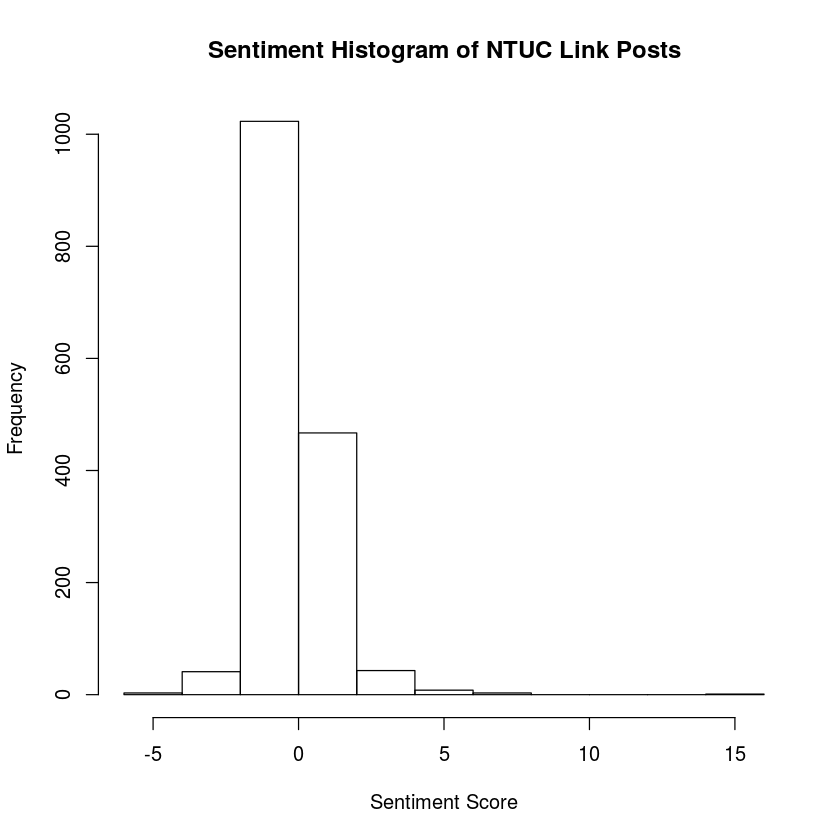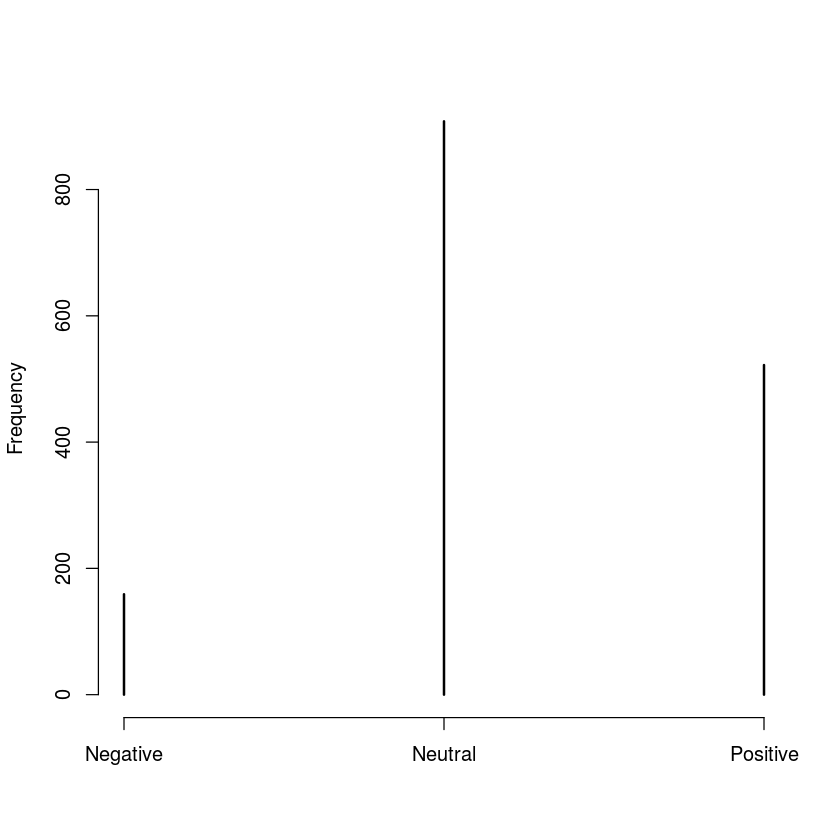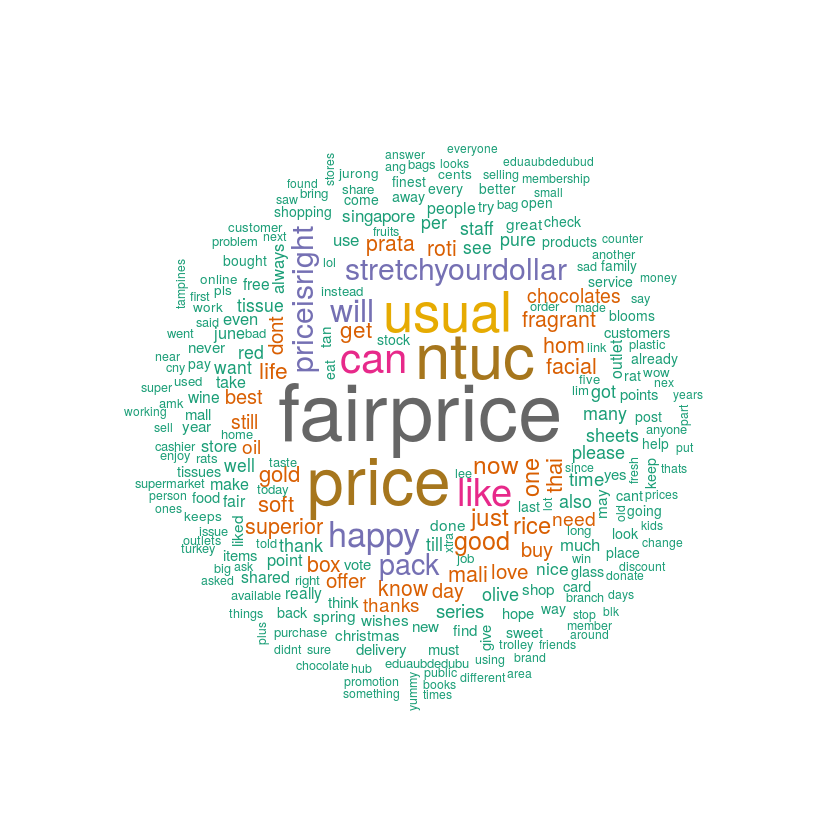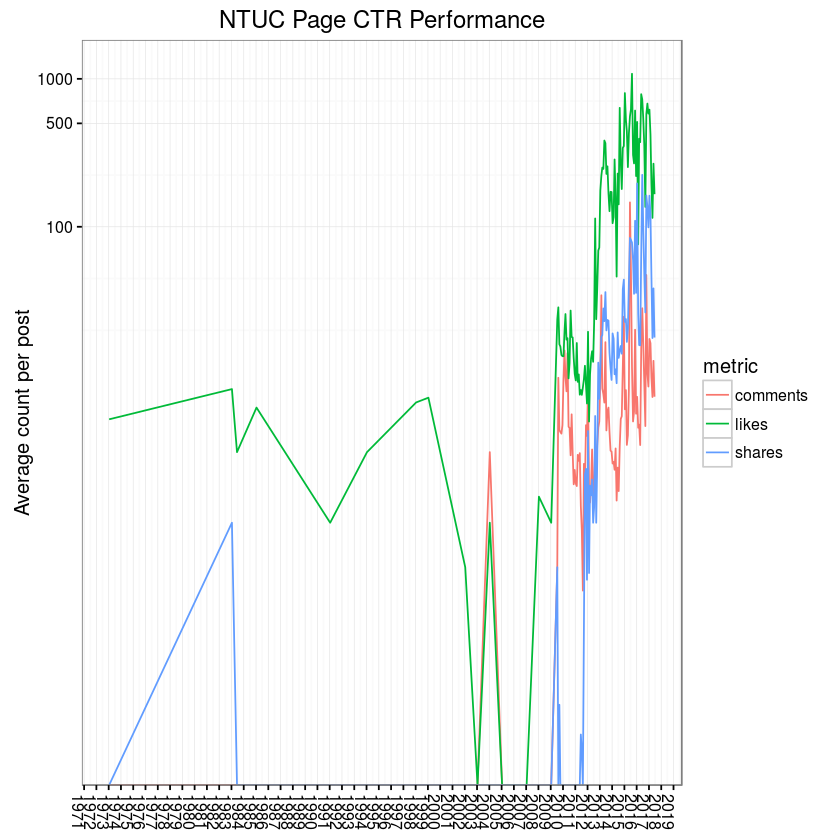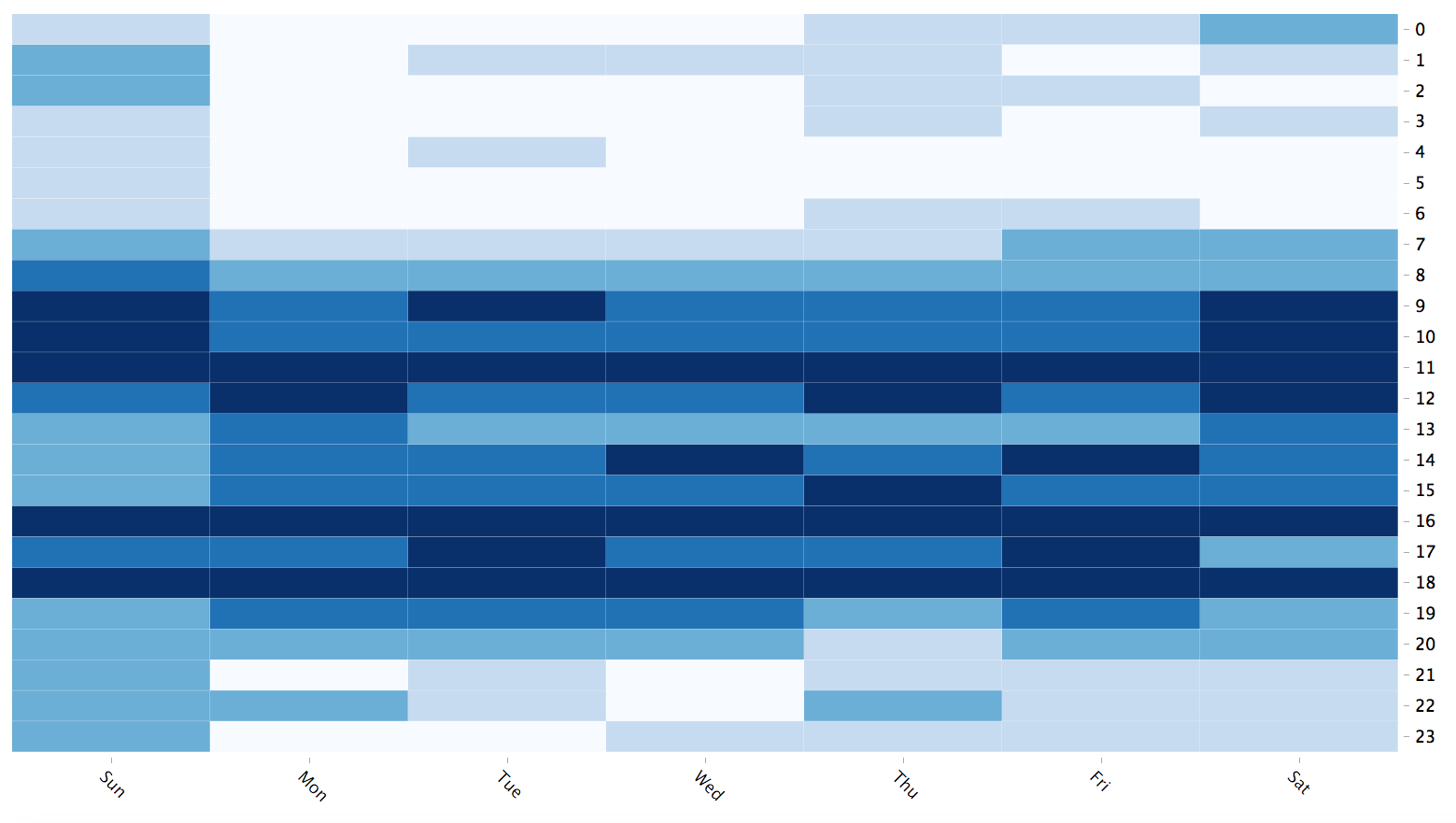Update: Permission is required for using Facebook Graph API to get information from public pages not owned by yourself
The Rfacebook package is authored and maintained by Pablo Barbera and Michael Piccirilli
This demo will provide a brief introduction in
- setting up and using the Rfacebook package to scrape public pages posts and comments.
- performing a simple lexicon-based sentiment analysis
- performing text frequency analysis with the use of word cloud will be applied
- plotting a simple trend analysis based on the page's "likes", "shares" and "comments"
- creating a heatmap of the page posts by day and time
- and the page's posting frequency.
- Installing the Rfacebook package
install.packages("Rfacebook")
library(Rfacebook)- Getting Temporary Access Token
- Get temporary (2hrs) FB access token via: https://developers.facebook.com/tools/explorer > click on Get Token
- Replace token <- "" with your token code
- You will need Graph API v2.6 and higher to get Reactions (love, haha, wow, sad, angry)
- Creating an App on Facebook Platform
- Create an app via: https://developers.facebook.com/
- Replace app_id="xxx" with your App ID code
- Replace app_secret="xxx" with your App Secret code
token <- "xxxxxxxxxx"
fb_oauth <- fbOAuth(app_id="xxx",app_secret="xxx",extended_permissions = TRUE)
save(fb_oauth, file="fb_oauth")
load("fb_oauth")- Get the latest 5000 posts their respective Reactions information from FB Page thatsmyfairprice
ntucPosts <- getPage("thatsmyfairprice", token, n = 5000, reactions = T)head(ntucPosts)| id | likes_count | from_id | from_name | message | created_time | type | link | story | comments_count | shares_count | love_count | haha_count | wow_count | sad_count | angry_count | post_datetime |
|---|---|---|---|---|---|---|---|---|---|---|---|---|---|---|---|---|
| 124299741408_10150633686196409 | 5 | 124299741408 | NTUC FairPrice | NA | 1973-01-01T08:00:00+0000 | link | https://www.facebook.com/124299741408/posts/10150633686196409/ | NTUC FairPrice added a life event from 1973: Founded in 1973. | 0 | 0 | 0 | 0 | 0 | 0 | 0 | 1973-01-01 08:00:00 |
| 124299741408_10150856484056409 | 8 | 124299741408 | NTUC FairPrice | NA | 1983-01-01T08:00:00+0000 | photo | https://www.facebook.com/thatsmyfairprice/photos/p.10150856484011409/10150856484011409/?type=3 | NTUC FairPrice added a life event from 1983: NTUC FairPrice Co-operative Ltd Formed. | 0 | 1 | 0 | 0 | 0 | 0 | 0 | 1983-01-01 08:00:00 |
| 124299741408_10150856485356409 | 3 | 124299741408 | NTUC FairPrice | NA | 1983-06-01T07:00:00+0000 | link | https://www.facebook.com/124299741408/posts/10150856485356409/ | NTUC FairPrice added a life event from June 1983: Used Textbook Project Launched. | 0 | 0 | 0 | 0 | 0 | 0 | 0 | 1983-06-01 07:00:00 |
| 124299741408_10150856487136409 | 6 | 124299741408 | NTUC FairPrice | NA | 1985-01-01T08:00:00+0000 | photo | https://www.facebook.com/thatsmyfairprice/photos/p.10150856487101409/10150856487101409/?type=3 | NTUC FairPrice added a life event from 1985: FairPrice Housebrand Products Introduced. | 0 | 0 | 0 | 0 | 0 | 0 | 0 | 1985-01-01 08:00:00 |
| 124299741408_10150856489041409 | 1 | 124299741408 | NTUC FairPrice | NA | 1991-01-01T08:00:00+0000 | photo | https://www.facebook.com/thatsmyfairprice/photos/p.10150856489011409/10150856489011409/?type=3 | NTUC FairPrice added a life event from 1991: First Retailer to Implement Bar-Coding at Check-Out Counters. | 0 | 0 | 0 | 0 | 0 | 0 | 0 | 1991-01-01 08:00:00 |
| 124299741408_10150856491601409 | 3 | 124299741408 | NTUC FairPrice | NA | 1994-01-01T08:00:00+0000 | photo | https://www.facebook.com/thatsmyfairprice/photos/p.10150856491566409/10150856491566409/?type=3 | NTUC FairPrice added a life event from 1994: Everyday Low Price (EDLP) Essential Items Introduced. | 0 | 0 | 0 | 0 | 0 | 0 | 0 | 1994-01-01 08:00:00 |
Check how many posts are scraped from the FB page
nrow(ntucPosts)2473
- Checking the distribution of post type of this FB page
table(ntucPosts$type) event link note photo status video
7 375 4 1555 321 211
plot(table(ntucPosts$type),ylab="Count of Post Type")- Let's take a look at the number of Likes & Reactions in each Post Type
install.packages("sqldf")
library(sqldf)postType <- sqldf("select type, count(type) as total_type_count,
sum(shares_count) as total_shares,
sum(likes_count) as total_likes,
sum(love_count) as total_love,
sum(haha_count) as total_haha,
sum(wow_count) as total_wow,
sum(sad_count) as total_sad,
sum(angry_count) as total_angry
from ntucPosts group by type")postType| type | total_type_count | total_shares | total_likes | total_love | total_haha | total_wow | total_sad | total_angry |
|---|---|---|---|---|---|---|---|---|
| event | 7 | 2 | 2786 | 10 | 1 | 0 | 0 | 0 |
| link | 375 | 9710 | 83335 | 560 | 93 | 484 | 12 | 18 |
| note | 4 | 4 | 26 | 0 | 0 | 0 | 0 | 0 |
| photo | 1555 | 34243 | 424959 | 3014 | 209 | 1419 | 172 | 138 |
| status | 321 | 2016 | 17255 | 6 | 47 | 20 | 8 | 192 |
| video | 211 | 38630 | 82989 | 1593 | 295 | 392 | 55 | 65 |
- Loop through all the posts and get their respective comments
ntucComment <- list()
for (i in 1:length(ntucPosts$id)){
ntucComment[[i]] <- getPost(ntucPosts$id[i], token, likes=F, comments=T)
ntucComment[[i]][['reactions']] <- getReactions(post=ntucPosts$id[i], token)
if (nrow(ntucComment[[i]][["comments"]]) == 0)
ntucComment[[i]][['comments']][1,] <- c(NA,NA,NA,NA,NA,NA,NA)
}
ntucComments <- do.call(rbind, lapply(ntucComment, data.frame, stringsAsFactors=FALSE))head(ntucComments)| post.from_id | post.from_name | post.message | post.created_time | post.type | post.link | post.id | post.likes_count | post.comments_count | post.shares_count | ... | comments.likes_count | comments.comments_count | comments.id | reactions.id | reactions.likes_count | reactions.love_count | reactions.haha_count | reactions.wow_count | reactions.sad_count | reactions.angry_count |
|---|---|---|---|---|---|---|---|---|---|---|---|---|---|---|---|---|---|---|---|---|
| 124299741408 | NTUC FairPrice | NA | 1973-01-01T08:00:00+0000 | link | https://www.facebook.com/124299741408/posts/10150633686196409/ | 124299741408_10150633686196409 | 5 | 0 | 0 | ... | NA | NA | NA | 124299741408_10150633686196409 | 5 | 0 | 0 | 0 | 0 | 0 |
| 124299741408 | NTUC FairPrice | NA | 1983-01-01T08:00:00+0000 | photo | https://www.facebook.com/thatsmyfairprice/photos/p.10150856484011409/10150856484011409/?type=3 | 124299741408_10150856484056409 | 8 | 0 | 1 | ... | NA | NA | NA | 124299741408_10150856484056409 | 8 | 0 | 0 | 0 | 0 | 0 |
| 124299741408 | NTUC FairPrice | NA | 1983-06-01T07:00:00+0000 | link | https://www.facebook.com/124299741408/posts/10150856485356409/ | 124299741408_10150856485356409 | 3 | 0 | 0 | ... | NA | NA | NA | 124299741408_10150856485356409 | 3 | 0 | 0 | 0 | 0 | 0 |
| 124299741408 | NTUC FairPrice | NA | 1985-01-01T08:00:00+0000 | photo | https://www.facebook.com/thatsmyfairprice/photos/p.10150856487101409/10150856487101409/?type=3 | 124299741408_10150856487136409 | 6 | 0 | 0 | ... | NA | NA | NA | 124299741408_10150856487136409 | 6 | 0 | 0 | 0 | 0 | 0 |
| 124299741408 | NTUC FairPrice | NA | 1991-01-01T08:00:00+0000 | photo | https://www.facebook.com/thatsmyfairprice/photos/p.10150856489011409/10150856489011409/?type=3 | 124299741408_10150856489041409 | 1 | 0 | 0 | ... | NA | NA | NA | 124299741408_10150856489041409 | 1 | 0 | 0 | 0 | 0 | 0 |
| 124299741408 | NTUC FairPrice | NA | 1994-01-01T08:00:00+0000 | photo | https://www.facebook.com/thatsmyfairprice/photos/p.10150856491566409/10150856491566409/?type=3 | 124299741408_10150856491601409 | 3 | 0 | 0 | ... | NA | NA | NA | 124299741408_10150856491601409 | 3 | 0 | 0 | 0 | 0 | 0 |
nrow(ntucComments)19518
There are 19518 rows of comments scraped but there are not actually 19518 comments being made. This is because some of the posts do not have any comments made and their respective comments columns will show NA.
First, let's proceed to standardize the dataframe variable names
names(ntucComments)- 'post.from_id'
- 'post.from_name'
- 'post.message'
- 'post.created_time'
- 'post.type'
- 'post.link'
- 'post.id'
- 'post.likes_count'
- 'post.comments_count'
- 'post.shares_count'
- 'comments.from_id'
- 'comments.from_name'
- 'comments.message'
- 'comments.created_time'
- 'comments.likes_count'
- 'comments.comments_count'
- 'comments.id'
- 'reactions.id'
- 'reactions.likes_count'
- 'reactions.love_count'
- 'reactions.haha_count'
- 'reactions.wow_count'
- 'reactions.sad_count'
- 'reactions.angry_count'
- We will replace all . with _ instead
names(ntucComments) <- gsub("\\.", "_", names(ntucComments))
names(ntucComments)- 'post_from_id'
- 'post_from_name'
- 'post_message'
- 'post_created_time'
- 'post_type'
- 'post_link'
- 'post_id'
- 'post_likes_count'
- 'post_comments_count'
- 'post_shares_count'
- 'comments_from_id'
- 'comments_from_name'
- 'comments_message'
- 'comments_created_time'
- 'comments_likes_count'
- 'comments_comments_count'
- 'comments_id'
- 'reactions_id'
- 'reactions_likes_count'
- 'reactions_love_count'
- 'reactions_haha_count'
- 'reactions_wow_count'
- 'reactions_sad_count'
- 'reactions_angry_count'
- Create a function that coverts FB date format to GMT
format.facebook.date <- function(datestring) {
date <- as.POSIXct(datestring, format = "%Y-%m-%dT%H:%M:%S+0000", tz="GMT")
}- Adding two new variable post_datetime & comments_datetime to ntucComments dataframe
This two variable will use the format.facebook.date function to convert the original FB date format to GMT format
ntucComments$comments_datetime <- format.facebook.date(ntucComments$comments_created_time)
ntucComments$post_datetime <- format.facebook.date(ntucComments$post_created_time)- Convert the comments variable column to ASCII
ntucComments$comments_message <- iconv(ntucComments$comments_message, "ASCII", "UTF-8", sub="")- Remove comments made by the organisation itself
ntucCommentsClean <- subset(ntucComments, comments_from_name != "NTUC FairPrice")- Substituting emoticons with text/descriptions
ntucCommentsClean$comments_message <- gsub(":-)", " happy ", ntucCommentsClean$comments_message)
ntucCommentsClean$comments_message <- gsub(";-)", " happy ", ntucCommentsClean$comments_message)
ntucCommentsClean$comments_message <- gsub(":)", " happy ", ntucCommentsClean$comments_message)
ntucCommentsClean$comments_message <- gsub(";)", " happy ", ntucCommentsClean$comments_message)
ntucCommentsClean$comments_message <- gsub("=p", " happy ", ntucCommentsClean$comments_message)
ntucCommentsClean$comments_message <- gsub(":p", " happy ", ntucCommentsClean$comments_message)
ntucCommentsClean$comments_message <- gsub(":P", " happy ", ntucCommentsClean$comments_message)
ntucCommentsClean$comments_message <- gsub("=P", " happy ", ntucCommentsClean$comments_message)
ntucCommentsClean$comments_message <- gsub("=)", " happy ", ntucCommentsClean$comments_message)
ntucCommentsClean$comments_message <- gsub(":-)", " happy ", ntucCommentsClean$comments_message)
ntucCommentsClean$comments_message <- gsub("<3", " love ", ntucCommentsClean$comments_message)
ntucCommentsClean$comments_message <- gsub(":\\(", " sad ", ntucCommentsClean$comments_message)
ntucCommentsClean$comments_message <- gsub(":-\\(", " sad ", ntucCommentsClean$comments_message)
ntucCommentsClean$comments_message <- gsub(":x", " oops ", ntucCommentsClean$comments_message)
ntucCommentsClean$comments_message <- gsub(":X", " oops ", ntucCommentsClean$comments_message)- Substituting line breaks, tabs, digits, url and punctuations with empty space
ntucCommentsClean$comments_message <- gsub("\n", " ", ntucCommentsClean$comments_message)
ntucCommentsClean$comments_message <- gsub("\t", " ", ntucCommentsClean$comments_message)
ntucCommentsClean$comments_message <- gsub("\\d", "", ntucCommentsClean$comments_message)
ntucCommentsClean$comments_message <- gsub("http[^[:blank:]]+", "", ntucCommentsClean$comments_message)
ntucCommentsClean$comments_message <- gsub("[[:punct:]]", "", ntucCommentsClean$comments_message)- Removing rows with less than 3 characters (I deemed to be not useful at all for text analysis)
ntucCommentsClean <- subset(ntucCommentsClean, nchar(comments_message) > 2)- load positive and negative lexicons
positives = readLines("positive-words.txt")
negatives = readLines("negative-words.txt")- Adding custom abbreviation / internet slangs to lexicon
positives = c(positives, 'thx', 'congrats', 'luv')
negatives = c(negatives, 'wtf', 'cancellation')- Installing required packages
install.packages("stringr")
install.packages("dplyr")
install.packages("plyr")
library(stringr)
library(dplyr)
library(plyr)Installing package into '/home/nbcommon/R'
(as 'lib' is unspecified)
Installing package into '/home/nbcommon/R'
(as 'lib' is unspecified)
Installing package into '/home/nbcommon/R'
(as 'lib' is unspecified)
Attaching package: 'dplyr'
The following objects are masked from 'package:stats':
filter, lag
The following objects are masked from 'package:base':
intersect, setdiff, setequal, union
------------------------------------------------------------------------------
You have loaded plyr after dplyr - this is likely to cause problems.
If you need functions from both plyr and dplyr, please load plyr first, then dplyr:
library(plyr); library(dplyr)
------------------------------------------------------------------------------
Attaching package: 'plyr'
The following objects are masked from 'package:dplyr':
arrange, count, desc, failwith, id, mutate, rename, summarise,
summarize
- Creating a simple scoring sentiment analysis function
score.sentiment = function(sentences, pos.words, neg.words, .progress='none')
{
require(plyr)
require(stringr)
scores = laply(sentences, function(sentence, pos.words, neg.words) {
sentence = gsub('[[:punct:]]', '', sentence)
sentence = gsub('[[:cntrl:]]', '', sentence)
sentence = gsub('\\d+', '', sentence)
sentence = tolower(sentence)
word.list = str_split(sentence, '\\s+')
words = unlist(word.list)
pos.matches = match(words, pos.words)
neg.matches = match(words, neg.words)
pos.matches = !is.na(pos.matches)
neg.matches = !is.na(neg.matches)
score = sum(pos.matches) - sum(neg.matches)
return(score)
}, pos.words, neg.words, .progress=.progress )
scores.df = data.frame(score=scores, text=sentences)
return(scores.df)
}ntucSentiScores <- score.sentiment(ntucCommentsClean$comments_message,positives,negatives,.progress = "text") |======================================================================| 100%
hist(ntucSentiScores$score,xlab="Sentiment Score")he histogram shows that most of the comments have a score hovering around the 0 score mark. The histogram depicts a normal distribution indicating that most of the comments are neutral with some positive and negative comments
- Now, let's add a new variable sentiment_polar to determine the sentiment of the comment
ntucCommentsClean$sentiment <- ntucSentiScores$score
ntucCommentsClean$sentiment_polar <- ifelse(ntucCommentsClean$sentiment == 0, "Neutral", ifelse(ntucCommentsClean$sentiment > 0, "Positive", "Negative"))head(ntucCommentsClean, n=2)| post_from_id | post_from_name | post_message | post_created_time | post_type | post_link | post_id | post_likes_count | post_comments_count | post_shares_count | ... | reactions_likes_count | reactions_love_count | reactions_haha_count | reactions_wow_count | reactions_sad_count | reactions_angry_count | comments_datetime | post_datetime | sentiment | sentiment_polar | |
|---|---|---|---|---|---|---|---|---|---|---|---|---|---|---|---|---|---|---|---|---|---|
| 13 | 124299741408 | NTUC FairPrice | NA | 2004-01-01T08:00:00+0000 | photo | https://www.facebook.com/thatsmyfairprice/photos/p.10150858221106409/10150858221106409/?type=3 | 124299741408_10150858221126409 | 1 | 3 | 0 | ... | 1 | 0 | 0 | 0 | 0 | 0 | 2012-06-08 09:23:48 | 2004-01-01 08:00:00 | 0 | Neutral |
| 15 | 124299741408 | NTUC FairPrice | NA | 2004-01-01T08:00:00+0000 | photo | https://www.facebook.com/thatsmyfairprice/photos/p.10150858221106409/10150858221106409/?type=3 | 124299741408_10150858221126409 | 1 | 3 | 0 | ... | 1 | 0 | 0 | 0 | 0 | 0 | 2015-03-04 19:44:11 | 2004-01-01 08:00:00 | -1 | Negative |
table(ntucCommentsClean$sentiment_polar) Negative Neutral Positive
1418 8884 6986
plot(table(ntucCommentsClean$sentiment_polar),ylab="Frequency")mean(ntucCommentsClean$sentiment)0.56461129106895
mean sentiment score of 0.56 indicates a mostly neutral and positive comments
You can continue to check the comments sentiments based on the post type as well
For e.g. sentiment for post_type = "link"
ntucLink <- subset(ntucCommentsClean, post_type == "link")
hist(ntucLink$sentiment, xlab = "Sentiment Score", main = "Sentiment Histogram of NTUC Link Posts")
table(ntucLink$sentiment_polar)
mean(ntucLink$sentiment)
plot(table(ntucLink$sentiment_polar),ylab="Frequency")Negative Neutral Positive
159 908 522
0.351793580868471
- Installing required packages for Text Analysis
Needed = c("tm", "SnowballC", "RColorBrewer", "wordcloud")
install.packages(Needed, dependencies=TRUE)Installing packages into '/home/nbcommon/R'
(as 'lib' is unspecified)
Warning message:
"dependencies 'Rcampdf', 'Rgraphviz', 'tm.lexicon.GeneralInquirer' are not available"also installing the dependency 'Rpoppler'
Warning message in install.packages(Needed, dependencies = TRUE):
"installation of package 'Rpoppler' had non-zero exit status"
- Creating corpus, lower case transformation, removing of punctuation / numbers and stopwords
library(tm)
# create corpus
corpus = Corpus(VectorSource(ntucCommentsClean$comments_message))
# Conversion to lower case
corpus = tm_map(corpus, content_transformer(tolower))
# Removal of punctuation
corpus = tm_map(corpus, removePunctuation)
# Removal of numbers
corpus = tm_map(corpus, removeNumbers)
# Removal of stopwords
corpus = tm_map(corpus, removeWords, stopwords("english"))Loading required package: NLP
- Generating wordcloud
library(wordcloud)
wordcloud(corpus, random.order = F, min.freq=2, max.words=250,
colors = brewer.pal(8, "Dark2"))- Creating function for aggregation matric
aggregate.matric <- function(metric){
m <- aggregate(ntucPosts[[paste0(metric, "_count")]],
list(month = ntucPosts$month),
mean)
m$month <- as.Date(paste0(m$month, "-15"))
m$metric <- metric
return(m)
}ntucPosts$timestamp <- format.facebook.date(ntucPosts$created_time)
ntucPosts$month <- format(ntucPosts$timestamp, "%Y-%m")df.list <- lapply(c("likes", "comments", "shares"), aggregate.matric)
df <- do.call(rbind, df.list)- Installing ggplot2 package
install.packages("ggplot2")
install.packages("scales")
library(ggplot2)
library(scales)Installing package into '/home/nbcommon/R'
(as 'lib' is unspecified)
Installing package into '/home/nbcommon/R'
(as 'lib' is unspecified)
Attaching package: 'ggplot2'
The following object is masked from 'package:NLP':
annotate
- Creating the trend plot
ggplot(df, aes(x = month, y = x, group = metric)) +
geom_line(aes(color = metric)) +
scale_x_date(date_breaks = "years", labels = date_format("%Y")) +
scale_y_log10("Average count per post", breaks = c(100, 500, 1000)) +
theme_bw() +
theme(axis.title.x = element_blank(), axis.text.x=element_text(angle = -90, hjust = 0)) +
ggtitle("NTUC Page CTR Performance") - Installing lubridate package to work with Date and Time
install.packages("lubridate")
library(lubridate)Installing package into '/home/nbcommon/R'
(as 'lib' is unspecified)
Attaching package: 'lubridate'
The following object is masked from 'package:base':
date
- Creating the relevant date and time variables
ntucPosts$datetime <- format.facebook.date(ntucPosts$created_time)
ntucPosts$dayweek <- wday(ntucPosts$datetime, label=T)
ntucPosts$dayint <- wday(ntucPosts$datetime)
ntucPosts$sghour <- with_tz(ntucPosts$datetime, "Asia/Singapore")
ntucPosts$hour <- hour(ntucPosts$sghour)- Installing heatmap package
install.packages("d3heatmap")
library(d3heatmap)Installing package into '/home/nbcommon/R'
(as 'lib' is unspecified)
also installing the dependency 'htmlwidgets'
- Creating heatmap of posts by day and time
heatmapFrame <- matrix(0,nrow=24,ncol=7);
rownames(heatmapFrame) <- 0:23
colnames(heatmapFrame) <- c("Sun", "Mon", "Tue", "Wed", "Thu", "Fri", "Sat")
for (i in 1:24) {
for (j in 1:7) {
heatmapFrame[i,j] <- nrow(subset(ntucPosts,dayint==j & hour==i-1))
}
}
d3heatmap(heatmapFrame, scale = "column",dendrogram = "none", color = scales::col_quantile("Blues", NULL, 5))You can amend the codes to create and show the day and time heatmap for customers' comments using the above provided code
- Finally, let's look at the posts frequency by the organisation
time.interval <- min(ntucPosts$datetime) %--% max(ntucPosts$datetime)
sampledays <- round(time.interval / ddays(1))
ntucPostFreq <- sampledays / nrow(ntucPosts)ntucPostFreq6.57096643752527
It seems that the organisation would create a new post every 6.5 days
Further analysis such as:
- comparision of organisation's post timing and customers' active timing can be performed to determine if the organisation is posting contents at the right time
- topic analysis (via the use of LDA) on customers' contents can be perform to determine what topics/subjects customers are talking about or are interested in



